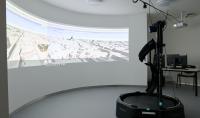Centre for Geospatial Analysis and Satellite Computing opened
A state-of-the-art infrastructure with a computing centre and a number of specialised laboratories has been established on the grounds of Warsaw University of Technology in Warsaw and the Scientific and Didactic Centre in Józefosław.
The ceremonial opening of the laboratories, which took place on 21 June 2023, is the culmination of the project launched in December 2018 and executed by the Faculty of Geodesy and Cartography of the Warsaw University of Technology together with consortium partners (OPEGIEKA, Intergraph/Hexagon, CloudFerro) as part of the Regional Operational Programme of the Mazowieckie Voivodeship. The project received funding from the European Union of over PLN 18 million.
The opening was divided into two parts – in Warsaw and in Józefosław.
During the meeting in Warsaw, the project was officially presented and summarised. The event was attended, among others, by the Rector of the Warsaw University of Technology, Professor Krzysztof Zaremba, the Director of the Mazovian Unit for Implementation of EU Programmes (MJWPU), Mariusz Frankowski, and the representative of the European Commission, Bartłomiej Balcerzyk.
– I am full of admiration that such a bold and visionary project has been created at the Faculty of Geodesy and Cartography of the Warsaw University of Technology – said the Rector of the Warsaw University of Technology.
MJWPU Director Mariusz Frankowski and Bartłomiej Balcerzyk from the European Commission stressed that the money provided for the creation of the Centre has been very well spent. This is demonstrated, for example, by the scientific projects already underway during the test period, which has been running from 2022 onwards, such as those related to the use of artificial intelligence tools in construction, the improvement of methods for the acquisition and processing of remote sensing data from UAVs or research into the terra transformation of Mars.
The second part of the opening, already in Józefosław, was attended by, among others, the Vice-Rector of the Warsaw University of Technology for Development, Prof. Adam Woźniak, the Mayor of Piaseczno, Daniel Putkiewicz, together with his deputies, Hanna Kułakowska-Michalak and Robert Widz, and representatives of the Mazovian Unit for Implementation of EU Programmes, headed by Anna Gręda. The visit to Józefosław was an opportunity to see the new laboratories and even test some of the equipment available.
The Centre for Geospatial Analysis and Satellite Computing (CENAGIS for short) is a research infrastructure consisting of two main parts: IT and stationary laboratories.
The IT base is formed by a computing centre (cloud infrastructure) mainly for processing terrain information. This part has two locations: WUT Main Building (MERCATOR cluster) and the centre in Józefosław (ROMER cluster).
The stationary laboratories are located in Józefosław. Available facilities are: a laboratory for testing laser scanners and digital cameras, laboratories for testing navigation and location applications (including a VR/AR laboratory), laboratories for GNSS (Global Navigation Satellite Systems) analysis and a gravimetric laboratory (for gravity acceleration measurements).
Jozefoslaw is also home to infrastructure related to permanent GNSS satellite observations (measuring station included in international research programmes).
– The CENAGIS infrastructure was created to support the process of expanding the scope, quality and efficiency of research in geoinformation and geospatial engineering in Poland, as well as to facilitate the commercialisation of research (by maintaining close relations with entrepreneurs from the stage of creating the Centre to its use) – says Dariusz Gotlib, PhD, professor from the Faculty of Geodesy and Cartography of the Warsaw University of Technology, the head of the CENAGIS project.
The infrastructure is also intended to enable the development and testing of new products by companies and to facilitate mutual contacts between scientists and entrepreneurs.
– The aim is also to develop solutions in cooperation between science and industry that can be used by various public institutions, hence a number of important agreements have already been concluded, e.g. with the Central Office of Weights and Measures, the Central Office of Geodesy and Cartography, the Polish Space Agency, the Ministry of Development and Technology – says Professor Gotlib. – CENAGIS is also becoming one of several dozen NATO DIANA (Defence Innovation Accelerator for the North Atlantic) test centres worldwide.
Dozens of people from the Warsaw University of Technology and from the companies forming the consortium were involved in the project. The main IT work was carried out by OPEGIEKA in collaboration with a team from the Faculty of Geodesy and Cartography and the Centre for Implementation of IT Solutions of the Warsaw University of Technology. The renovation and construction work was coordinated by the team of the WUT Chancellor.








